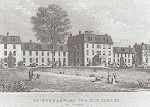Difference between revisions of "Portal:Featured Article Of The Week"
M-Explorer (talk | contribs) |
M-Explorer (talk | contribs) |
||
| Line 1: | Line 1: | ||
{{FAformat | {{FAformat | ||
| − | |Title= | + | |Title= Friends Hospital |
| − | |Image= | + | |Image= Friends.gif |
|Width= 150px | |Width= 150px | ||
| − | |Body= | + | |Body= The original building, now known as the 'Scattergood Building' was designed to be North facing, and 322 feet high with a stone edifice. It was placed at considerable distance from the public road, which is now Roosevelt Blvd., some five hundred feet. Two wings, 100 feet long, flanking the front of the structure were completed on both sides. However, unlike Kirkbride's plans, they were not intended to discriminate between a clinical population. This building was made fellow to a small adjoining library, as well as a hospital garden, which was perceived as being crucial to the treatment of the insane in the 19th century. |
| − | + | The asylum was originally purposed for the care and treatment for members of the Society of Friends exclusively. However, with a change in Pennsylvania law, the Board of Managers put it to a vote and elected to remove the sectarian restrictions in 1834. Dr. Thomas Story Kirkbride, the father of American Psychiatry is record as having done his medical residency at Friends Asylum, before going on to found the Institute of the Pennsylvania Hospital in 1841. | |
| − | + | As with many asylums, a superintendent's house was constructed on the campus in 1859, for the easy access of medical staff. Likewise, the steward's house was built nearby in 1910. These buildings, Lawnside and Greystone, were operational until recently, until they were re-purposed by the administration of Friends Hospital. | |
| − | In | + | In 1871, extensive changes were made to the Scattergood building . $20,000 were secured from the Society of Friends for this reason. In this renovation a small bronze plaque was placed along the side of the building to commemorate its history. That plaque is still in place and recounts the founding of the hospital and its prominent Quaker origins. [[Friends Hospital|Click here for more...]] |
}} | }} | ||
Revision as of 04:52, 11 February 2013
Featured Article Of The Week
Friends Hospital
The original building, now known as the 'Scattergood Building' was designed to be North facing, and 322 feet high with a stone edifice. It was placed at considerable distance from the public road, which is now Roosevelt Blvd., some five hundred feet. Two wings, 100 feet long, flanking the front of the structure were completed on both sides. However, unlike Kirkbride's plans, they were not intended to discriminate between a clinical population. This building was made fellow to a small adjoining library, as well as a hospital garden, which was perceived as being crucial to the treatment of the insane in the 19th century.
The asylum was originally purposed for the care and treatment for members of the Society of Friends exclusively. However, with a change in Pennsylvania law, the Board of Managers put it to a vote and elected to remove the sectarian restrictions in 1834. Dr. Thomas Story Kirkbride, the father of American Psychiatry is record as having done his medical residency at Friends Asylum, before going on to found the Institute of the Pennsylvania Hospital in 1841.
As with many asylums, a superintendent's house was constructed on the campus in 1859, for the easy access of medical staff. Likewise, the steward's house was built nearby in 1910. These buildings, Lawnside and Greystone, were operational until recently, until they were re-purposed by the administration of Friends Hospital.
In 1871, extensive changes were made to the Scattergood building . $20,000 were secured from the Society of Friends for this reason. In this renovation a small bronze plaque was placed along the side of the building to commemorate its history. That plaque is still in place and recounts the founding of the hospital and its prominent Quaker origins. Click here for more...
